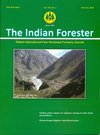Climate Change Mitigation: Role of forest Sector
DOI:
https://doi.org/10.36808/if/2018/v144i2/122492Keywords:
Climate Change, Mitigation, Sequestration, Substitution, Storage.Abstract
Paris Agreement, adopted by 197 countries in 2015 reaffirm the goal of limiting the increase in global temperatures to well below 2°C compared with pre-industrial levels, with an ambition to limit the increase to 1.5°C, necessitating accelerated climate change mitigation measures. The important role of forests in mitigation of climate change is universally recognized. This can broadly be classified into Sequestration, Storage and Substitution. Sequestration involves increasing the removals of CO2 from the atmosphere by activities like afforestation, reforestation, forest restoration, and increasing the tree cover by agro-forestry, farm forestry, urban plantations and similar activities. Storage of carbon is achieved by reducing deforestation and forest degradation, forest conservation and managing the forests for biodiversity and Substitution involves use of wood fuels as a substitute for fossil fuels as well as use of wood in place of carbon intensive materials such as steel and cement concrete. Recognizing the critical role of the forest sector in climate change mitigation, forest management strategies need to be realigned to maximize carbon sequestration, storage and substitution. This strategy also provides substantial co-benefits in the form of livelihood opportunities and numerous goods and services from forests.References
Anon. (2014). National climate assessment US global change research program. 1800 G street, NW, Suite 9100, Washington DC.
Anon. (2016). Climate finance thematic briefing: REDD+ finance. Climate Fund Update, Nov 2016. Overseas Development Institute, 203 Blackfriars Road, London, UK.
FAO (2010a). Global forest resource assessment 2010 main report. FAO Forestry Paper 163. Food and Agriculture Organization of the United Nations, Rome. Document retrieved at: http://www.fao.org/publications/en/
FAO (2010b). Managing forests for climate change. FAO Forestry Paper. 1-20 pp.
FAO (2013). Climate change guidelines for forest managers. FAO Forestry Paper – 172. www.fao.org/forestry. 63-67 pp.
FAO (2016). Forestry for low carbon future. FAO Forestry Paper – 177. www.fao.org/forestry.
Gopalakrishnan R., Jayaraman M., Bala G. and Ravindranath N. H. (2011). Climate Change and Indian forests: Current Science, 101(3): 348355.
Grassi, Giacomo, House Jo, Dentener, Frank, Federici, Sandro, Elzen, Michel den and Penman, Jim. (2017). The key role of forests in meeting climate targets requires science for credible mitigation. Nature Climate Change, 7: 220-226.
IPCC (2007). Climate change 2007: Synthesis report, summary for policymakers,C/O World Meteorological Organization,7bis Avenue de la Paix, C.P. 2300,CH- 1211 Geneva 2, Switzerland
IPCC (2013). Working Group I Contribution to the IPCC Fifth Assessment Report Climate Change 2013: The Physical Science Basis. http://www.ipcc.ch/publications.
ISFR (2013). India State of Forest Report - 2013. Forest Survey of India, MoEF, GoI, Dehradun.
ISFR (2015). India State of Forest Report - 2015. Forest Survey of India, MoEF, GoI, Dehradun.
Kishwan J., Pandey R. and Dadhwal V. K. (2010). India's forest and tree cover: Contribution as a carbon sink. ICFRE Technical Paper, ICFRE, P.O. – New Forest, Dehradun.
Krishna Hari P. and Reddy S.C., (2012). Assessment of increasing threat of forest fires in Rajasthan, India using multi-temporal remote sensing data (2005–2010). Current Science, 102 (9): 1288-97.
Kurz W.A., Stinson G., Rampley G.J., Dymond C.C. and Neilson E.T. (2008). Risk of natural disturbances makes future contribution of Canada's forests to the global carbon cycle highly uncertain. Proc. Nat. Acad. Sci. USA, 105: 1551–1555.
MoEF (2010). India: Greenhouse Gas Emissions 2007, Ministry of Environment and Forests, Government of India, New Delhi.
MoEF (2011). National Mission for a Green India, Ministry of Environment and Forests, Government of India, New Delhi.
MoEF (2012). Indian Second National Communication to the Unted Nations framework Convention on Climate Change. Ministry of Environment and Forests, Government of India, New Delhi.
Sharma S.K., Bhattacharya S. and Garg A. (2003). India's initial national communication (NATCOM) to United Nations framework convention on climate change and the forestry sector. Indian Forester, 129(6): 673- 681.
Srivastava P. and Garg A. (2013). Forest fires in India: Regional and temporal analyses. J. Tropical Forest Science, 25(2): 228-239.
UNFCCC (2003). Caring for climate – a guide to climate change convention and the Kyoto Protocol. Climate Change Secretariat, Martin – Luther – King – Strasse 8, 53175, Bonn, Germany.
UNFCCC (2004). Modalities and procedures for afforestation and reforestation project activities under the clean development mechanism in the first commitment period of the Kyoto Protocol. Decision 19/CP 9, UN Framework Convention on Climate Change FCCC/CP/2003/6/Add.2 30 Bonn, Germany.
UNFCCC (2017). Retrieved from http://www.unfccc.int.
Downloads
Downloads
Published
How to Cite
Issue
Section
License
Unless otherwise stated, copyright or similar rights in all materials presented on the site, including graphical images, are owned by Indian Forester.





